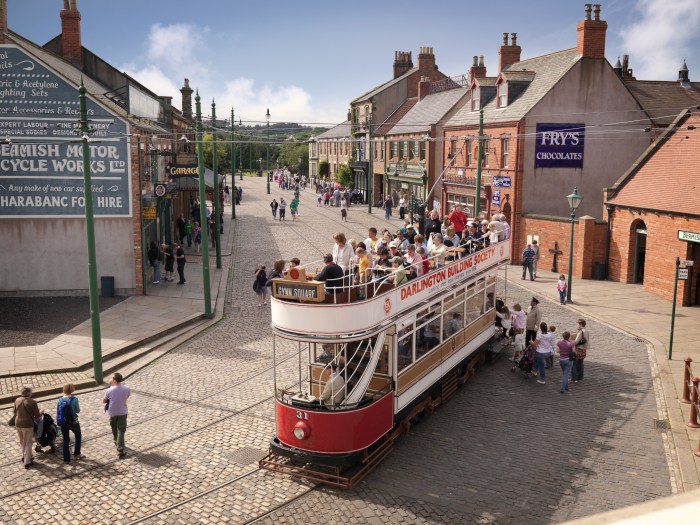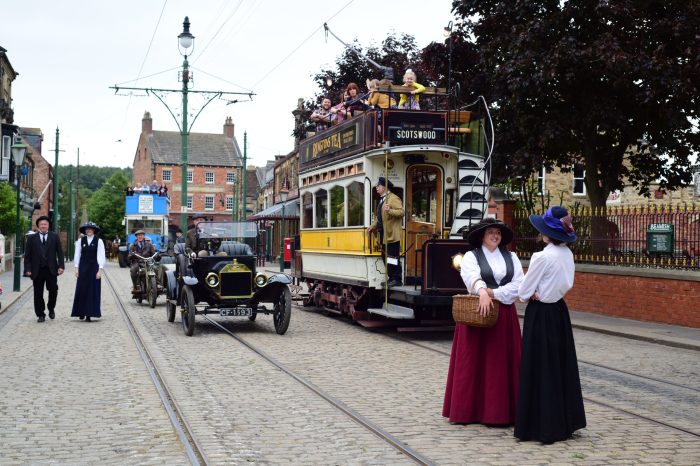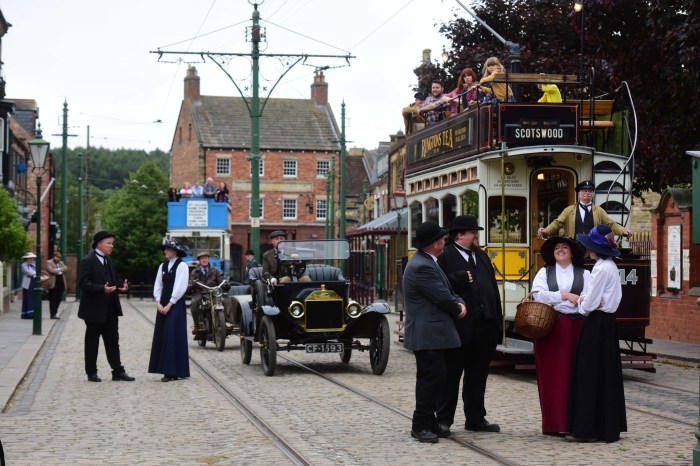Beamish Museum, a captivating open-air museum in County Durham, England, invites visitors to embark on a remarkable journey through time, showcasing the rich industrial and social heritage of the region. Established in 1970, Beamish Museum has grown into a beloved destination, offering an immersive and interactive experience that brings the past to life.
From its humble beginnings as a collection of historic buildings to its current status as a thriving museum complex, Beamish Museum has played a pivotal role in preserving and interpreting the region’s industrial heritage. Its vast collection of exhibits, educational programs, and community outreach initiatives have made it a valuable resource for understanding the social, economic, and technological changes that have shaped the area over the centuries.
Historical Significance
The Beamish Museum is a living history museum located in County Durham, England. It is one of the largest and most popular open-air museums in the United Kingdom, attracting over 350,000 visitors each year.
The Beamish Museum, a living history museum, offers a captivating glimpse into the past. After immersing yourself in the authentic sights and sounds of a bygone era, escape to the breathtaking Amalfi Coast , where dramatic cliffs meet turquoise waters.
Indulge in the region’s culinary delights and soak up the picturesque beauty before returning to the Beamish Museum to delve further into the fascinating tapestry of the past.
The museum tells the story of life in the North of England from the 1820s to the 1950s. It features over 40 reconstructed buildings, including houses, shops, a school, a church, and a farm. Visitors can experience what life was like in these different periods through interactive exhibits, demonstrations, and costumed interpreters.
Timeline of Key Events
- 1958: The Beamish Open Air Museum is founded by Frank Atkinson, a local businessman and historian.
- 1960: The museum opens to the public.
- 1970: The museum is granted charitable status.
- 1980: The museum opens its first new exhibition, the Pockerley Old Hall.
- 1990: The museum opens its second new exhibition, the 1950s Town.
- 2000: The museum opens its third new exhibition, the Georgian Town.
- 2010: The museum opens its fourth new exhibition, the 1940s Farm.
- 2020: The museum celebrates its 60th anniversary.
Collections and Exhibits

Beamish Museum houses a diverse array of collections and exhibits that bring the past to life. These collections encompass a wide range of artifacts, machinery, and buildings, each contributing to the museum’s immersive and educational experience.
The exhibits are meticulously curated to present a comprehensive narrative of life in the North of England during the 18th, 19th, and early 20th centuries. Visitors can explore the social, economic, and technological changes that shaped the region during this period.
Beamish Museum is a fascinating open-air museum that transports visitors back in time to experience life in the early 1900s. If you’re planning a trip to Beamish, be sure to check the Bahamas weather forecast to ensure you have the most enjoyable experience.
Beamish is a great place to visit any time of year, but the weather can be unpredictable, so it’s always best to be prepared.
Industrial Revolution
- The museum features a fully operational colliery, complete with a winding engine and headgear, showcasing the pivotal role of coal mining in the region’s industrial development.
- The Pockerley Waggonway, a reconstructed 1820s railway, demonstrates the transformative impact of transportation on industry and trade.
- The 1913 Beamish Pit Village depicts the living and working conditions of miners and their families, providing insights into the social challenges and triumphs of the era.
Rural Life
- The museum’s extensive collection of farm animals, including rare breeds, highlights the importance of agriculture in rural communities.
- Visitors can witness traditional farming practices, such as plowing with horses and shearing sheep, showcasing the challenges and rewards of rural life.
- The 1820s Town Farm depicts the self-sufficient lifestyle of a typical farming family, complete with a farmhouse, outbuildings, and livestock.
Preservation and Conservation
Beamish Museum is committed to the preservation and conservation of its collections. The museum’s team of experts employs specialized techniques to restore and maintain artifacts, ensuring their longevity for future generations.
Beamish Museum offers an unparalleled glimpse into the past, showcasing the industrial heritage of the region. For a change of pace, consider a trip to Bend, Oregon , renowned for its outdoor recreation opportunities. From hiking to mountain biking, Bend offers an array of activities to invigorate your spirit.
Upon returning to Beamish Museum, immerse yourself once more in the rich tapestry of history it presents.
The museum also actively participates in research and conservation projects, collaborating with other institutions and organizations to advance the understanding and preservation of the region’s heritage.
Educational Programs and Outreach

Beamish Museum offers a comprehensive range of educational programs and outreach initiatives that engage with the community and promote heritage awareness. These programs aim to connect people with the past, inspire learning, and foster a deeper understanding of our shared history.
The museum collaborates with schools, universities, and community groups to provide educational experiences tailored to different age groups and learning objectives. Through hands-on workshops, interactive exhibits, and guided tours, visitors can immerse themselves in the sights, sounds, and smells of the past.
Workshops and Events
Beamish Museum hosts a variety of workshops and events throughout the year, providing opportunities for hands-on learning and engagement with the museum’s collection and staff. These include:
- Blacksmithing workshops, where participants learn the art of forging metal.
- Baking workshops, offering hands-on experience in traditional bread-making techniques.
- Living history demonstrations, showcasing the skills and daily lives of people in the past.
- Community events, such as family days and heritage festivals, that bring the museum to life and foster a sense of community.
Educational Resources
Beamish Museum also provides a range of educational resources, both online and offline, to support learning and research. These resources include:
- An extensive online collection of photographs, documents, and artifacts, accessible through the museum’s website.
- Lesson plans and teaching materials, aligned with national curriculum standards, for use in schools and educational settings.
- A dedicated research library, housing a wealth of historical documents and resources.
Visitor Experience
The Beamish Museum offers an immersive and interactive experience that transports visitors back in time. With amenities such as accessible pathways, cafes, and restrooms, the museum ensures a comfortable and enjoyable visit for all. Guided tours provide expert insights into the museum’s exhibits, bringing the history of the region to life.
Interactive and Immersive Elements, Beamish museum
The Beamish Museum goes beyond static displays, offering hands-on experiences that enhance visitor engagement. Visitors can participate in traditional crafts, such as pottery and weaving, or try their hand at vintage games. Interactive exhibits, like the pit village schoolhouse, allow visitors to step into the past and experience life as it was over a century ago.
Visitor Demographics, Attendance, and Feedback
The Beamish Museum attracts a diverse range of visitors, from families and school groups to history enthusiasts and international tourists. Annual attendance figures consistently exceed 400,000, demonstrating the museum’s popularity and relevance. Visitor feedback is overwhelmingly positive, with many praising the museum’s authenticity, educational value, and engaging experiences.
Impact on Tourism and Economic Development: Beamish Museum

The Beamish Museum is a significant economic driver for the local and regional economy. As a popular tourist attraction, it generates substantial revenue and supports numerous businesses in the surrounding area.
Tourism Revenue
The museum attracts over 400,000 visitors annually, many of whom come from outside the region. These visitors spend money on accommodation, dining, transportation, and other services, contributing millions of pounds to the local economy. A study by the University of Sunderland estimated that the museum’s annual economic impact on the region exceeds £20 million.
Job Creation
The Beamish Museum is a major employer in the area, providing over 200 full-time and part-time jobs. These jobs include roles in visitor services, conservation, education, and administration. The museum also creates indirect employment opportunities through its supply chain and the tourism industry it supports.
Case Study
In 2019, the Beamish Museum launched a major expansion project, which included the construction of a new 1950s town. The project created over 100 new jobs during the construction phase and is expected to attract an additional 100,000 visitors annually, further boosting the local economy.
Conclusion

Beamish Museum stands as a testament to the enduring power of heritage and the importance of preserving our collective past. Its commitment to education, community engagement, and economic development has made it a cornerstone of the region, inspiring generations to appreciate and learn from the stories of those who came before them.
FAQ Summary
What are the admission prices for Beamish Museum?
Admission prices vary depending on the time of year and type of ticket. Please check the Beamish Museum website for current pricing.
Are there guided tours available at Beamish Museum?
Yes, guided tours are available for an additional fee. Tours cover various aspects of the museum’s exhibits and history.
Is Beamish Museum accessible for visitors with disabilities?
Yes, Beamish Museum is committed to accessibility. The site has designated accessible routes, ramps, and facilities for visitors with mobility impairments.